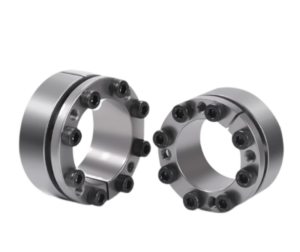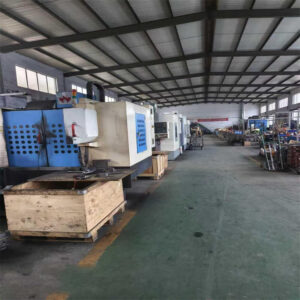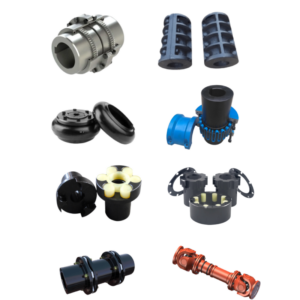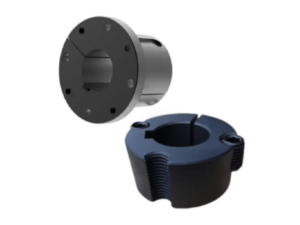Couplings come in many varieties. Based on their ability to compensate for relative displacement (misalignment) between shafts and their working principles, they can be mainly classified into the following categories:
I. Rigid Couplings
These couplings are simple in structure, low-cost, transmit high torque, and offer good rigidity. However, they require the connected shafts to be perfectly aligned (high concentricity and parallelism) and cannot compensate for any relative displacement (radial, axial, or angular misalignment). Misalignment can cause significant additional loads on the shafts and bearings, leading to vibration, wear, or even damage. Suitable for low-speed, heavy-duty applications with extremely high alignment accuracy.
- Flange Coupling:
- Structure: Consists of two flanged half-couplings bolted tightly together.
- Characteristics: Simplest structure, most widely used, transmits high torque, good rigidity, requires extremely high concentricity.
- Types: Centering spigot type (centered by a shoulder and groove) and fitted bolt type (centered by close fit between bolts and holes).
- Application: Low-speed, heavy-duty, well-aligned shaft systems, e.g., some fixed heavy machinery.
- Sleeve Coupling:
- Structure: Uses a common sleeve connected to both shaft ends via keys, pins, or interference fit.
- Characteristics: Most compact structure, smallest radial size. But difficult to assemble/disassemble (requires axial movement of shaft or coupling), requires high concentricity.
- Application: Low-power, low-speed applications with identical shaft diameters and limited space.
II. Flexible Couplings
This is the most widely used type of coupling. They allow for certain relative displacements (radial, axial, angular misalignment) between the connected shafts and can absorb vibration and cushion shock. Based on how they compensate for displacement and whether they contain elastic elements, they are further divided into:
A. Flexible Couplings without Elastic Elements (Compensating Rigid Couplings)
These couplings compensate for displacement through relative sliding or clearance between their components. Transmit high torque but have no cushioning or damping capability. Require lubrication.
- Gear Coupling:
- Structure: Comprises two flanged sleeves with external gear teeth (half-couplings) and two housings with internal gear teeth. Torque is transmitted via meshing internal and external gears.
- Characteristics: Extremely high torque capacity (up to tens of thousands of Nm), reliable, allows significant combined misalignment (especially angular and radial), long life. But complex structure, heavy, requires good lubrication and sealing, high manufacturing precision, costly.
- Application: Heavy machinery, metallurgical equipment, mining machinery, marine propulsion systems, and other high-speed, heavy-duty applications.
- Oldham Coupling (Cross-slider Coupling):
- Structure: Consists of two half-couplings with diametrical grooves and a center disc with tenons (cross-slider) on both sides. The tenons fit into the grooves of the half-couplings.
- Characteristics: Relatively simple structure, small radial size, compensates for large radial displacement (Δy) and small angular displacement (Δα). But sliding friction between slider and grooves causes wear, requires lubrication; centrifugal force at high speed causes slider deflection, increasing dynamic loads and wear; lower efficiency.
- Application: Suitable for low-speed (< 300 rpm), large radial displacement, medium torque applications, e.g., some vertical pumps.
- Universal Joint (U-Joint / Hooke’s Joint):
- Structure: A single joint consists of a cross (spider) connecting two yokes (forks). Often used in pairs (double universal joint) in practice to maintain constant velocity.
- Characteristics: Transmits motion and power between shafts intersecting at large angles (or parallel but offset) (Δα up to 15°-45°). Compact structure, relatively easy maintenance. Single joint causes non-constant instantaneous angular velocity (fluctuation).
- Application: Automotive drive shafts, rolling mills, machine tools, construction machinery, etc., where large-angle power transmission is needed.
B. Flexible Couplings with Elastic Elements (Elastic Couplings)
These couplings compensate for displacement through the elastic deformation of their elements and simultaneously provide cushioning, damping, and noise reduction. They are the most widely used type. Based on the material of the elastic element, they can be divided into metallic and non-metallic elastic element types.
Non-Metallic Elastic Elements (Most Common)
- Pin Bush Coupling (Flexible Pin Coupling with Bushings):
- Structure: Similar to a flange coupling, but the connecting bolts have rubber (or nylon) bushings/sleeves inserted into corresponding holes in the half-couplings.
- Characteristics: Simple structure, easy to manufacture, easy assembly/disassembly, low cost, provides some cushioning and damping. Compensates only small displacements (especially axial), bushings wear and age easily.
- Application: Very common for medium/small power, frequently started, reversing, medium/low-speed shaft systems requiring cushioning.
- Elastic Pin Coupling:
- Structure: Uses several pins made of non-metallic material (e.g., nylon) passing through holes in the flanges of two half-couplings.
- Characteristics: Similar to pin bush coupling, but higher torque capacity (more pins possible), simpler structure, allows small axial displacement. Good cushioning and damping. Pin shear strength is a weak point.
- Application: Medium/low-speed, light/medium loads, transmissions with vibration/shock, e.g., hoists, conveyors, pumps, fans.
- Jaw Coupling / Spider Coupling (often with a “LAM” or “L” shaped elastomer):
- Structure: Two identical jaw-shaped half-couplings and a star-shaped/spider elastomer (polyurethane or rubber). The elastomer is compressed between the jaws.
- Characteristics: Compact, small radial size, no lubrication needed, easy maintenance, strong misalignment compensation (especially angular and radial), good cushioning and damping, often zero-backlash transmission. Elastomer is the wear part.
- Application: Very widespread, from precision servo systems to general industrial equipment (pumps, fans, compressors, textile machinery). Especially suitable for applications requiring compensation for significant misalignment or with vibration/shock.
- Star Coupling (often with a multi-legged star elastomer):
- Structure: Similar to jaw coupling, but elastomer is typically star-shaped (multi-legged), mating with bosses on the half-couplings.
- Characteristics: Performance very similar to jaw couplings, also offering misalignment compensation, cushioning, damping, maintenance-free, compact. Sometimes offers more uniform stress distribution under torque.
- Application: Highly overlaps with jaw couplings.
- Tyre Coupling:
- Structure: Uses a tire-shaped elastic element made of rubber or rubber-cord, connected to the two half-couplings via bolts.
- Characteristics: High elasticity, strong misalignment compensation (especially angular and radial), excellent cushioning and damping, electrical insulation, no relative friction, no lubrication needed. But low torsional stiffness, large axial size, susceptible to temperature and oil degradation.
- Application: Suitable for applications with high shock, frequent starts, high damping requirements, or difficult shaft alignment, e.g., cranes, excavators, marine power plants.
Metallic Elastic Elements
- Diaphragm Coupling:
- Structure: Composed of one or more sets of thin metal (stainless steel) diaphragms stacked and alternately bolted to the driving and driven hubs.
- Characteristics: High torque density (high torque in small size), high rigidity (zero or minimal backlash), no wear, no lubrication, maintenance-free, long life, high-temperature resistant, corrosion-resistant, strong misalignment compensation (especially angular and axial). Torsional stiffness can be designed (linear/non-linear). High manufacturing precision required, higher cost.
- Application: High-speed, high-power, high-precision transmissions, e.g., turbo machinery (pumps, compressors, fans), generator sets, marine propulsion, high-speed motors, servo systems. A high-end mainstream product in modern industry.
- Bellows Coupling:
- Structure: Core element is a thin-walled metal (stainless steel) bellows, welded or clamped at both ends to hubs.
- Characteristics: High torsional stiffness, zero-backlash transmission, high precision (no hysteresis), no friction, maintenance-free, high-temperature resistant, corrosion-resistant. Primarily compensates angular and axial displacement, weak radial compensation. Lower load capacity compared to diaphragm couplings.
- Application: Particularly suitable for precision positioning, low torque, high-speed applications, e.g., precision measuring instruments, semiconductor equipment, medical devices, small servo motors.
Summary: Key Selection Points
Choosing the right coupling requires considering these key factors:
- Torque Transmission: Magnitude and nature (steady-state, peak, shock loads).
- Speed: Operating speed range, operation near/above critical speeds.
- Shaft Misalignment: Required compensation for radial, axial, angular displacement.
- Operating Environment: Temperature, humidity, dust, oil, corrosive media.
- Cushioning/Damping Requirements: Need to absorb vibration and shock.
- Installation/Maintenance Requirements: Space constraints, ease of assembly/disassembly, need for lubrication/maintenance.
- Precision Requirements: Need for zero-backlash or high torsional rigidity.
- Cost: Budget constraints.
- Bore Type & Size: Connection method (keyway, clamp, taper lock) and shaft diameter.
Simplified Guide:
- Strict Alignment Required, Low-Speed, Heavy-Duty: Consider Rigid Couplings (Flange Type).
- Misalignment Allowed, Cushioning/Damping Needed, General Purpose: Elastic Couplings (Jaw/Star, Elastic Pin/Pin Bush) are the first choice, offering high cost-effectiveness.
- High-Speed, High-Power, High-Precision, Maintenance-Free: Diaphragm Coupling is the mainstream choice.
- High Precision, Low Torque, High Speed: Bellows Coupling.
- Heavy-Duty, Large Misalignment Compensation (Especially Angular): Gear Coupling or Universal Joint.
- High Shock, High Elasticity Required: Tyre Coupling.
In practical engineering applications, Jaw/Star Elastic Couplings, Elastic Pin Couplings, and Diaphragm Couplings are currently the most widely used types.







